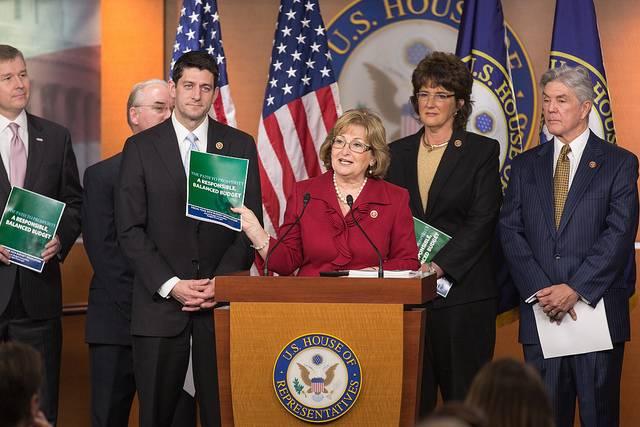Coca-Cola Great Britain launches deposit return scheme in Scotland


How Conservatives Could Save the Environment and Grow the Economy


By Katie McBeth
It’s something we can expect every four or eight years. When the White House switches from Republican to Democrat, or vise-versa, it happens.
Policies are changed; reversed; abolished.
It often results in outcry from the opposing side, but it should be expected. The opposing platforms stand on opposite sides of almost every issue. Bipartisan support is becoming rarer and rarer in the modern age.
However, after a solid eight years of Barack Obama’s push for green energy and job growth, the new administration’s attempts to reverse the emphasis could bring significant damage to our current economy.
Green energy is blossoming all around the world. Even if government feelings on sustainability shift, it is still projected to grow over the next decade, and businesses everywhere are embracing the potential to “go green.” It is the new fuel, and jumping ship on the movement now could put the American economy in the path to failure. Not only this, but halting the growth of this industry could also prevent significant job growth and an economic advantage in the global market.
As Donald Trump’s administration ramps up on pipeline production and promises to increase jobs within the U.S., they could find rare bipartisan support through the recent proposal of a measure known as the Conservative Case for Carbon Dividends.
Switching the trajectory
As Trump prepared to enter the White House, his tower in New York saw an increasing number of visits from foreign CEOs and national businesses. As a businessman, much of Trump’s campaign banked on the promises of job growth and the “forgotten middle-class worker.” In fact, much of his support came from folks in the middle of the U.S. who sincerely believed Trump could bring back their coal-mining or factory jobs.
Yet, visit after visit from international businessmen showed a serious lack of consideration for this particular group of people.
Alibaba’s CEO, Jack Ma of China, met with the then-president-elect to discuss opening a branch of the company's successful marketplace in America. However, this would only result in customer service jobs or freelance artists having a new platform to sell their wares.
Softbank CEO, Masayoshi Son of Japan, saw an instant rise in profits after his meeting with Trump, which promised an expansion of the business into America as well. Yet this would only provide jobs within retail (Softbank is a cell phone company) and more customer service call centers.
These are only a handful of examples within the weeks preceding Trump’s inauguration. His meetings spurred hope, with promises of thousands of jobs opening on U.S. soil, but the promises were empty when considering the industries they occupied.
Retail and customer service positions within massive corporations rarely benefit the worker but always benefit the millionaire owners, often adding to the increase in wage disparity in the United States. Positions may be created, but hours and wages will remain low, and workers will suffer. So will our credibility within the global marketplace. In truth, there appears to be very little thought for the needs of the people who overwhelmingly voted for Trump.
However, if Trump and his team were to take on climate change, he could genuinely help those people who banked on his election win. His team would need to make a dramatic shift in their stance on climate change and green energy. This could be hard to imagine, as he’s not one to admit fault or failure, but it could happen -- and it could prove to be highly successful among his fans and his opponents.
Conservative conservation
On Feb. 8, the Climate Leadership Council met to discuss the latest proposals and accomplishments of the past year. One stand-out moment was the proposal of the Conservative Case for Climate Dividends, which was first introduced to the public through a piece in the New York Times.
The proposal -- co-authored by eight men, five of whom are renowned veteran Republican leaders -- lays out a detailed plan that promises domestic job growth and competitive international sanctions that all promote green energy and reducing carbon emissions. The plan stands on four pillars that -- if followed according to plan -- will please everyone.
“These four pillars, combined, invite novel coalitions. Environmentalists should like the long-overdue commitment to carbon pricing. Growth advocates should embrace the reduced regulation and increased policy certainty, which would encourage long-term investments, especially in clean technologies. Libertarians should applaud a plan premised on getting the incentives right and government out of the way. Populists should welcome the distributive impact.” (NY Times, 2017)
It’s a rare moment that the Trump administration and the Republican party is faced with: Go with the tide and continue the push for jobs that promote climate conservation, or ignore the measure and potentially create an even larger hole in the ozone layer while low-income and middle-class workers continue to fight over meager wages.
But there are significant reasons (beyond the obvious global benefit) for considering this new measure. For one, the global marketplace will be forced to listen to our demands, something that is sure to allure the negotiator within Trump.
But another, potentially more promising angle for Republicans is the support they would receive from middle-class workers. Jobs within the coal-mining and oil industry are dying. Clean power is already making a positive impact on the environment and providing ample career opportunities. Promoting construction and maintenance jobs for green energy will prove to be more in-line with the experience this group of people have. Fitting a coal miner into a retail position is unrealistic. Fitting a coal miner into a position that builds solar panels is more pragmatic.
This move will build real jobs that offer real competitive salaries and benefits. Agreeing to this new action will not just appeal to others on the political spectrum, but it also will win Republican votes from low- to middle-income workers for years to come. Isn’t that their whole objective as a political party?
Time will tell if this new proposal will make waves within Congress. Although it is unlikely that they will acknowledge the potential lined out in the Conservative Case, it is possible that increased pressure from constituents will force their hand.
As three of the proposal's authors wrote in their op/ed in the New York Times: “On-again-off-again regulation is a poor way to protect the environment. And by creating needless uncertainty for businesses that are planning long-term capital investments, it is also a poor way to promote robust economic growth.”
Whether they like it or not, the world is changing in favor of green energy. Republicans can either get on board and create some real potential for growth, or they can continue to fight against the flow and hurt themselves in the process.
Image credit: Flickr/Speaker John Boehner
Katie McBeth is a researcher hailing from Boise, ID. She spends her free time reading teen novels and being the mother of three cats and a dog named Toby. You can follow her animal and writing adventures on Instagram or Twitter: @ktmcbeth.
Tensions Simmer In Standing Rock Protest Camps As Evacuation Nears


North Dakota may have a newly elected governor, but the state's position regarding the controversial Dakota Access Pipeline and its resident 'water protectors' appears to have stayed the same.
North Dakota Gov. Doug Burgum issued an emergency evacuation order for the largest of the Standing Rock protest camps last week, saying the few hundred remaining protesters have until Feb. 22 to pack up and leave.
The directive reinforces orders issued in November by the U.S. Army Corps of Engineers and Burgum's predecessor, which were directed at "large populations" who gathered in support of the Dakota Access Pipeline protests. At the time, the Corps stated that while it was calling for protesters to leave, it had no intention of forcibly evicting residents.
But that's all changed. On Wednesday, North Dakota's new governor said the arrival of the spring thaw makes the federal lands unsafe for the 300 or so water protectors still present in the camp.
“Warm temperatures have accelerated snowmelt in the area of the protest camp," the evacuation order reads, "and the National Weather Service reports that the Cannonball River should be on the watch for rising water levels and an increased risk of ice jams later this week."
According to the governor's order, North Dakota' early spring thaw will not only endanger the occupants of the largest camp, Oceti Sakowin, but could also increase risk that debris and belongings on the site will be swept into the Missouri River by floodwaters.
Officials maintain that the land is now littered with "debris and the human waste" and that the area isn't being cleaned up quickly enough to avert an environmental disaster.
Tribal members concede that there is still a lot to clean up from protesters who have since left the camp, and say they are encouraging those still present to help the tribe return the federal site to its original condition. The tribe has not issued a statement affirming the actual condition of the public protest site or whether human waste is present.
The tribe has also asked protesters to go home. In a Jan. 21 Facebook post, the Standing Rock Tribe said it had passed a unanimous resolution calling for the closure of all of the protest camps.
"[We] ask the protectors to vacate the camps and head home with our most heartfelt thanks. Much work will be required to clean up before the spring thaw, which will flood the area. It is imperative we clean the camps and restore them to their original state before this flooding occurs."
On Friday, protestors met with state and federal officials and asked for additional time to finish cleaning up the area, but the state says it plans to hire private contractors to finish the work. Burgum also says he plans to ask the federal government to pick up the tab for the cleanup, which he estimates will be about $33,000.
And the tribe, which at times was forced to mediate tensions between outside protesters and police, now faces a new protracted legal battle. Tribal leaders say the Donald Trump administration's decision to green-light the Dakota Access Pipeline abruptly halted an Environmental Impact Statement still in progress. The tribe also faces the ongoing economic impacts of road closures and local tensions.
The Standing Rock Sioux may feel it is no longer in the position to defend protesters' right to use federal land as a camping area. According to a blog post published by Warrior Publications, the tribe's decision to close the various camps was the result of a tribal council meeting in which members discussed the various steps local authorities had taken to restrict movement of protesters. Those actions included the razing of a tipi that the tribe says was not within the construction zone and the closure of a bridge that tribal members used for daily transportation. The bridge closure sparked a protest in which a number of attendees were injured.
Last week the Bureau of Indian Affairs took steps to close down the first protest site, which attendees were initially told was on the private land of Lakota historian LaDonna Brave Bull Allard. According to the Bureau, Allard owns less than 0.10 percent of the land known as the Sacred Stone camp. The rest is held by the Bureau "in trust for the Standing Rock Tribe." Allard and her guests now face trespass violations and court dates.
The move is an awkward if not clear signal to protesters that their activism on the Dakota Access front lines was meant only to be temporary. The real fight, as the tribe has said all along, is encouraging companies and banks to divest from the oil sector and avert what would have far greater environmental impact than an abandoned makeshift campground: an undetected crude oil spill.
The Standing Rock Sioux Tribe's journey to global activism carries lessons as well. It's tough to oversee thousands of concerned activists who turn up for your cause, use public lands as if they were their own, and have no real understanding of the environmental impact their actions will leave behind. At what point does the responsibility of ensuring there is adequate garbage and sewage disposal become an urgent mandate? Hopefully not at the end of a protest.
But the case also signals a lesson about the difficult path environmental activism may face in the future as it tries to marshal the support of the public on its own front lines.
Where do organizations draw the line when thousands -- or tens of thousands -- want to come out and show their support for a fragile ecology? How do you house them, how do you promote a culture of camaraderie and how, as the Standing Rock Sioux have struggled to figure out, do you diplomatically communicate goodbye when it's time?
Image credit: Flickr/ USFWS Mountain Prairie
3 Signs the Hydrogen Economy is For Real


The dream of a zero-emission hydrogen economy amounted to little more than pixie dust just a few years ago. But that was then and this is now.
In the first part of February alone, three big stories about hydrogen fuel cells in the U.S., Japan and Germany demonstrate that the hydrogen economy is already beginning to deliver on its promise of abundant, zero-emission fuel.
One important caveat still applies: Hydrogen sourced through renewable energy is a key element in a sustainable hydrogen economy, but that only applies to a relatively small number of projects as of now. Mainstream saturation is still years away, so for now natural gas and other fossils are the primary source of hydrogen.
What is the hydrogen economy?
The hydrogen economy refers to the use of cheap, abundant hydrogen to fuel sustainable growth.
The problem is that hydrogen does not occur naturally in a usable state. It has to be produced from other compounds, and that takes energy.
When the term was first coined in the 1970s, the supposition was that abundant nuclear energy would be the driver.
The nuclear energy idea fell out of favor as the true costs (and risks) of the technology became apparent, and it looked as if that was the end of the dream.
As recently as 10 years ago, the consensus among experts was that hydrogen production would require too much energy to make an effective alternative to fossil fuels.
In 2006, Phys.org cited one representative study:
"A hydrogen economy is a wasteful economy. The large amount of energy required to isolate hydrogen from natural compounds (water, natural gas, biomass), package the light gas by compression or liquefaction, transfer the energy carrier to the user, plus the energy lost when it is converted to useful electricity with fuel cells, leaves around 25 percent for practical use — an unacceptable value to run an economy in a sustainable future."
But the equation has changed with the advent of high-efficiency wind turbines and solar cells, which produce zero-emission electricity that can be used to split water and create hydrogen. Tidal energy is also coming into play.
That has not changed all hearts and minds, notably that of Tesla CEO and co-founder Elon Musk. However, the market has spoken: Demand for hydrogen fuel cells is growing, as the following three examples illustrate.
1. The hydrogen fuel cell hotel
On Feb. 8, the hospitality company Radisson Blu teamed with energy company E.ON to announce the launch of a new fuel cell system at the iconic Frankfurt Radisson Blu.
The two companies cited the advantage over conventional building energy systems:
"They generate electricity and heat in a non-combustion process which is virtually absent of pollutants such as nitrous oxide or fine dust particles," the companies said in a press release."The use of fuel cell technology allows the Radisson Blu hotel to generate a large share of the energy needed to run the hotel free of emissions."
The Frankfurt Radisson Blu is a stylish monument to modern architecture and design, located in the architectural heart of Germany, making the new project significant -- and highly visible.
The use of a fuel cell in this building sends a clear message that fuel cells are the wave of the future.
The project also signals that hydrogen fuel cell technology is mature and capable of providing a significant amount of power for major structures.
The Radisson Blu has 400 rooms and suites along with other facilities, and the expectations are high:
"Starting in late summer 2017, the fuel cells will supply about 3 gigawatt hours (GWh) of electricity and 2 GWh of heat to the hotel. The highly-efficient technology also allows the Radisson Blu to reduce CO2 emissions by about 600 tons a year. This amount is equal to the CO2 emissions from 50,000 cars driving 100 kilometers."
2. Japan doubles down on hydrogen
On Feb. 9, Bloomberg News published an update on the hydrogen and fuel cell initiatives of Toyota, Panasonic, Toshiba, and JX Nippon Oil and Energy. The Japanese firms are working on various elements of this ambitious initiative:
"The Japanese government is targeting 1.4 million installations of 'ene-farm' residential fuel-cells by 2020 and 5.3 million by 2030," Chisaki Watanabe of Bloomberg reported.
The near-term goal coincides with the 2020 Tokyo Olympic Games, during which Japan aims to showcase its technology:
"The capital has announced plans to spend 45.2 billion yen ($400 million) on fuel-cell vehicle subsidies and hydrogen stations by the time of the games. Toyota envisions more than 100 fuel-cell buses crisscrossing the nation’s capital by then."
As for the long term, Bloomberg notes that Japan is waiting on the results of a hydrogen supply chain study before it looks past 2020. This is the here and now:
"Hydrogen isn’t expected to play a dominant role as a source of energy in Japan any time soon," Watanabe concluded. "The nation’s 2030 power mix, an outlook published by the trade ministry in 2015, makes no mention of hydrogen."
That reluctance may be partly due to an assumption that the country would need to rely on imported natural gas as a primary source for hydrogen.
But that assumption may eventually fall by the wayside. Toshiba, for example, recently launched a solar-powered hydrogen fuel station, and Toyota unveiled a soup-to-nuts wind powered hydrogen economy demonstration project in 2015.
3. More hydrogen for the U.S.
Over here in the U.S., interest in hydrogen is burgeoning. One particularly interesting mashup pairs the legacy transportation company Ryder with startup truck manufacturer Nikola for fuel cell trucks and a network of solar-powered fueling stations.
The Energy Department also ramped up its funding for fuel cell projects last year, including funding for water-splitting powered by renewable energy. On Jan. 19, the agency awarded an innovation prize aimed at stimulating the development of a fueling station network, though funding for any and all of the agency's clean-energy initiatives is uncertain these days.
In the latest development, on Feb. 20 the U.K. company Intelligent Energy paired with the American cylinder compressed gas transportation company Luxfer-GTM Technologies on a line of fuel cell products to replace diesel generators.
Intelligent Energy's fuel cell technology will be integrated with the company's 'Zero-Set' line of transportable fuel cell generators, with an initial focus on Luxfer-GTM's light towers.
The U.S. military, for one, is transferring over to fuel cell technology because it is quiet and odorless, providing benefits for the health and well-being of personnel as well as an important tactical advantage.
Luxfer-GTM details the advantages of fuel cell technology over diesel engines from a power management perspective:
"Fuel cells provide 60 percent operating efficiencies over traditional gas/diesel generators, which are 20 to 25 percent efficient, all while providing unparalleled reliability since there are almost no moving parts."Depending upon duty cycle and cylinder configuration, the ZeroSet-Gen 3 can provide continuous, 24/7 power for 18 days or longer. Additionally, fuel cells provide stable power curves for specific applications where clean power wave energy is critical."
In announcing the new venture, Intelligent Energy Senior VP Julian Hughes took the opportunity to pitch his two cents into the hydrogen economy debate:
“I see this as showing our great commitment to the U.S. market, one of the world’s leading hydrogen economies."
Waiting to hear back from Mr. Musk in 5...4...3...2...
Image (screenshot): via Intelligent Energy.
2018 World Cup in Russia is Toxic to Sponsors


The quadrennial World Cup is the world’s biggest sporting event, far outpacing the Super Bowl and the Olympics. FIFA, football’s global governing body, claimed that the 2014 World Cup in Brazil scored 3.2 billion viewers, with 1 billion watching the final between Germany and Argentina.
The 32-team tournament is typically a global gold mine for FIFA and its sponsors, who spent up to US$50 million to have their brands associated with the event. In 2013, FIFA accumulated $404 million in marketing rights for the Brazil World Cup, which funded almost 30 percent of its revenue that year.
But so far, the World Cup set to kick off in Moscow next year has struggled with signing up sponsors. Some of the usual suspects, including Adidas, Coca-Cola, Visa and Russia’s energy giant Gazprom, are sponsoring next summer’s month-long event.
But as Bloomberg reported this week, one problem is the exorbitant marketing fees FIFA expects from businesses for sponsorship, which are now as high as $150 million. Additionally, the corruption scandal that dogged FIFA for much of 2015 has sullied the sporting body’s reputation. During that year, World Cup-related marketing fees plunged almost 40 percent, down to $246 million.
Resentment against FIFA has simmered for years as more countries are realizing that the press coverage and prestige that arise from hosting the sporting world’s premier event come with a huge cost.
While most analysts lauded FIFA for the 2010 South Africa World Cup -- the first in Africa -- those stadia have become a financial burden and sparked little economic development, save for temporary construction and tourism jobs.
Four years later, Brazil’s enthusiasm for hosting its first World Cup since 1950 dissipated as the country’s plunging economy and declining social services made its role as World Cup host seem frivolous to many citizens. Many of the newly built stadiums across Brazil now sit empty as they are too expensive for local professional football teams to maintain.
The murky circumstances surrounding the surprising 2010 decision to award next year’s World Cup to Russia and the 2022 event to Qatar have also nudged companies to step away from FIFA.
Accusations of corruption reached the point at which rumors suggested both countries would be stripped of their hosting bids. Last year, outgoing FIFA President Sepp Blatter admitted that the decision to hold the 2018 World Cup in Russia was a fait accompli even before the final vote.
Qatar’s hosting of the event also came under attack, and not only for the dubious decision to hold a sporting tournament in a small country with no football tradition and where the mercury can surpass 110 degrees Fahrenheit in the summer. The event has since been moved to November and December despite protests from the European football leagues. Meanwhile, critics described the construction of the stadia in and around Doha, Qatar, as a human rights catastrophe.
Between FIFA’s recent performance and Russia’s overall reputation as one of the most corrupt nations on earth (Transparency International scores Russia 131st out of the 176 nations it surveys), the Switzerland-based sporting association is a brand with which most companies are not in a rush to associate. Memories of the 2014 Winter Olympics in the summer resort of Sochi, a boondoggle that saw its budget soar from $12 billion to $51 billion, offer more reminders of the rampant corruption that defines Russia.
It could take years for FIFA to recover and become a trusted organization again. Holding the 2026 tournament in a country with a rich football tradition (England), or one with a squeaky clean reputation (Canada), or even where new stadia are not necessary (the U.S. or Japan) would be a start. And having the 2030 tournament co-hosted by Argentina and Uruguay, the latter of which hosted the first World Cup in 1930, could prove that at the very least FIFA respects tradition as much as it seeks to extort billions of dollars from countries desperate to hold such an event.
Image credit: Government of Moscow/Wiki Commons
In Munich, Talk Of Climate Change and Growing Risk of War


You may have heard that U.S. Vice President Mike Pence spoke at the Munich Security Conference over the weekend to assure allies they have nothing to worry about when it comes to aggression from Russia or President Donald Trump’s rhetoric.
What was not widely reported in the media, with the exception of Bloomberg and a few other sources, is the growing concern that climate change risks could escalate social conflicts around the globe.
Patricia Espinosa Cantellano, head of the United Nations’ climate change agency, said 200 million people worldwide were displaced due to natural disasters between 2008 and 2015. Such risks have doubled since 1970. And in addition to the human misery, the financial costs of disasters related to climate volatility have soared to about US$200 million a year.
“Climate change is a driving force behind the instability that causes displacement,” Ms. Espinosa Cantellano said during a panel discussion on climate security in Munich on Saturday.“Climate change is the threat multiplier that worsens social, economic and environmental pressures leading to social upheaval, and possibly even violent conflict.”
According to a report commissioned by G-7 nations last year, the growing demand for food, water, and energy is hampering the work being done to alleviate poverty and boost economic development in developing countries.
Add the impacts of unresponsive or incompetent governments, rising inequality and political upheaval, and one outcome is an increase in human migration. Extreme weather, which leads to volatile food and energy prices, could foment even more social unrest.
Furthermore, the competition for water resources, especially along transnational borders, could cause further tension during this century. Sea-level rise could also spark conflict over ocean resources and shipping lanes.
The attempted solutions seem obvious: climate mitigation strategies and humanitarian aid paired with sustainable economic development programs. But the G-7 survey also suggests more peace-building and conflict-prevention programs. One problem is that, with all the discussion over how to plan for a warming climate while ensuring that poorer countries can still build their economies, there is still a disconnect between peace-building and accounting for environmental risks.
The authors of the G-7 report suggested a framework such as the New Deal for Engagement in Fragile States, which strives to partner wealthier nations with developing countries to strengthen national security, political participation, social services, revenue collection and economic development.
What this 'New Deal' lacks, however, is the integration of environmental and climate risks and how they affect government policies, a country’s business climate and, of course, citizens.
Climate change aid programs such as the one recently announced by Sweden could help build resilience where the need is greatest, but funds are sorely lacking.
In a world that struggles with a bevy of crises, from poverty to corruption to human rights violations, the integration of environmental stewardship and climate change risks sounds like an overwhelming and complicated task. But as Bloomberg’s Eric Roston wrote last summer, “The question is no longer just whether climate change will kill us, but also whether climate change will make us kill each other.”
If climate change cannot be pinned down as the definitive cause of global conflict yet, there is definitely a correlation: A recent study led by German researchers suggested that almost a quarter of wars in ethnically-divided nations sparked around or during a climate-related natural disaster. And in a 30-year period from 1980 to 2010, 9 percent of all armed conflicts worldwide occurred during a heat wave or drought.
None of this may be news: A 2013 study led by the University of California, Berkeley and Princeton University suggests that links to a changing climate and wars are nothing new in human history, from Europe to Asia to Mesoamerica.
Image credit: Oxfam International/Flickr
Wisdom Can Be Bipartisan


A look at the website for mindfulness conference Wisdom 2.0 paints a certain picture of the gathering and for whom it is designed: Splashed on the homepage are images of Tibetan monks creating sand art, sage-like speakers imparting wisdom to large crowds, people assembled in yoga poses, and group hugs. Yes, group hugs.
While a certain dose of new-age spirit can be an asset at an event like this, you don’t have to be a meditation expert or even a yogi to appreciate the messages at Wisdom 2.0. The self-proclaimed premier gathering for “exploring living mindfully in the digital age,” Wisdom 2.0 offers a forum to learn, share and experience the benefits of conscious thought in everyday action. Especially given today’s times, this mindset is valuable, if not downright necessary, to create positive social impact and build a sustainable future.
A stream running through this year’s conference was an exploration of the role of mindfulness in bridging gaps and moving forward beyond political divisiveness. The following session titles shed light on what was discussed: Race, Justice, and Mindfulness: Addressing Society’s Pain, Inequity, and Disenfranchisement Through the Lenses and Practices of Mindfulness, Wisdom, and Compassion; A Manifesto for Challenging Wisdom in Challenging Times: Guidance for Cultivating a Fierce Heart; Exercising Leadership and Practicing Compassion in Politically Charged Times; and Inquiry, Politics, and The Mind.
In a series of conversations presented on the main stage, speakers shared words of wisdom on how to take action and practice compassion in our current sociopolitical climate. Here are a few key teachings from those talks.
Everybody deserves to be heard
Whether in a boardroom, classroom or picket line, everybody deserves the opportunity to express their opinions — whether you agree with them or not. This is one of the main lessons Byron Katie, renowned self-inquiry author and teacher, imparted to the Wisdom 2.0 crowd.
“I wanted to change the world,” Katie shared with Wisdom 2.0 attendees, “so I questioned my judgements, beliefs, and assumptions about the world, and the world changed as my mind made the shift.”
If you see the world a certain way and oppose another person’s worldview, the answer is not to shut them down; rather, allow them to speak their piece and look at what needs to change within you to make peace. As Katie put it, “Change takes consciousness, leadership and goodness.”
Wisdom starts from within
Challenging times are often reflected in social media feeds, and what we’re all seeing in our feeds these day is nothing less than stressful. It’s easy to get overwhelmed and enter a reactive or defensive stance, but mindfulness teacher Jon Kabat-Zinn reminds us: “Social justice is at the heart of mindfulness, and we must reawaken to the need for compassion in all areas of our lives.”
In other words, compassion and mindfulness should not be relegated to spare moments in a day on a yoga mat or in a dark, quiet room. Space for mindfulness can be equally held at work and with friends, family and strangers.
Integrity is reflected in action
All of this, of course, is easier said than done, but actions do speak louder than words. Whether your values compel you to work at a purpose-driven organization, meet with your local elected officials, protest at airports, or march on the streets, what matters most is that these actions reflect a deep level of compassion and awareness of others.
Laney Whitcanack, CEO of the non-partisan nonprofit organization Coro Northern California, shared the following:
“You can choose to 1) fight, 2) ignore, or 3) create connection. On an individual level, you have to be brave to ask for permission to seek to understand others and undertake this kind of bridge-building. My question is: How can we create spaces that are trans-partisan so that all people know how to get engaged with compassion?”
In the same session on exercising leadership and practicing compassion in politically-charged times, Rhonda V. Magee, a professor at the University of San Francisco School of Law, added:
“We really need each other to have a broad perspective of the truth and chart the way forward. Having love and compassion is what it takes to connect under these times.”
In a world where everyone lives in their own world and gets to define their own truth, social justice can only thrive when inclusivity survives. Left, right or middle of the road, positive outcomes can only come about if all sides approach dialogue with mindfulness. That is wisdom that stands — regardless of where you stand on the political spectrum.
The Vegan Food Boom is Good for People, Planet and Profit


By Anna Johansson
Most people think of veganism as a highly-debated personal issue, one related to health and nutrition, but few outside the vegan community stop to think about how such a diet impacts our environment.
For vegan-centered businesses, however, our food choices aren’t just about physical health; they're about global sustainability and long-term economic health. It goes far beyond changing the way we eat, but rather is a statement about how we treat our planet and what kind of future we hope to have and intend to create.
Nutrition facts: Protein and profits
When people talk about veganism, the first question most people ask is: But where do you get your protein? Due to a lack of nutrition education, many Americans think that the only way to get protein is through meat products, and many even over-consume meat products, believing it’s necessary for their health when it’s, in fact, bad for their bodies and the environment.
In fact, vegetarians and vegans can get their protein from many non-meat sources, including soy, nuts and nut butters, peas, seeds and even whole grains. Grains like quinoa are actually very high in protein, as are peas. Meat eaters are often surprised to hear that these foods they think of as poor sources of protein can boast more protein than an equivalent serving of meat.
With this in mind, then, companies are rapidly centering alternative protein sources in their business plans. Ruoquette, a French company, is in the process of bringing the world’s largest pea protein factory to Canada. And in the U.S., plant-based foods contribute $13.7 billion to the economy. And because of its complexity and status as a near-complete protein, pea protein alone is expected to be an $18.5 million industry by 2021.
Our health, our earth
Health food, in the broadest sense, has become a viable, mainstream marketing point rather than just a niche market, and vegan protein sources are a key example of this. In part, this is because of an increase in health issues. The risks of things like heart disease, type 2 diabetes and some kinds of cancer can be reduced by a vegan diet.
In this day and age, however, it’s not just our health we should be worried about. Rather, we need to consider how what we eat impacts the health of the earth and this kind of ethical appeal works well for vegan-centered companies.
Simply put, a vegan diet has a much smaller carbon footprint than diets that include meat and animal products. In 2017, if everyone across the globe switched to a plant-based diet, we could reduce greenhouse gas emissions related to food-production by 70 percent by 2050. That’s an enormous reduction.
Looked at more carefully, there’s an even more intimate link between our health and the health of our earth because of the implications of global warming.
When 80 percent of food-production greenhouses gases are related to meat production, evidence suggests veganism may be the only answer.
Waste not
In addition to reducing greenhouse gas emissions, a vegan diet has other environmental benefits that could decrease resource scarcity around the world – but only if changes are made on a corporate, rather than individual, scale.
A quick look at resources needed to produce a cup of beef versus a cup of kidney beans makes it clear why. From land and water to fertilizer and fuel, it takes fewer resources to grow the kidney beans and they’re better for you. Considering the scarcity of potable water, the amount of land devoted to animal agriculture, and the damages done by fossil fuels, why wouldn’t we want to reduce our use of these critical resources?
It’s within reach
Finally, it’s important to put to bed the fiction that vegan diets are not attainable for many people, particularly those living on limited incomes. Let’s take, as an example, the fact that veganism and vegetarianism are practiced most widely in the developing world.
Even among those who don’t identify with this particular dietary practice, meat tends to be a relatively minor part of people’s daily diets – it’s expensive and ultimately out of reach, saved for celebrations or when guests are invited. It isn’t a staple in the way it is in the United States. And the more popular plant-based diets become, the less expensive basic meat alternatives will become.
Animal agriculture is the enemy of the environment and the enemy of our health, but it has distinct advantages for today’s food businesses. As advocates for the earth, then, it’s time to push for a vegan revolution. High-end restaurants are catching on, vegan “butchers” are opening, and your local grocery increasingly stocks vegan alternatives.
Now, more businesses need to step up and support this change.
Image credit: Pexels
Anna is a freelance writer, researcher, and business consultant. A columnist for Entrepreneur.com, HuffingtonPost.com and more, Anna specializes in entrepreneurship, technology, and social media trends. Follow her on Twitter and LinkedIn.
GSK's innovative business model for marketing and sales


Grocery Trade Association Launches New Food Dating Initiative: Can It Work?


Depending on the source, anywhere from a third to 40 percent of all food in the U.S. is wasted. One of the culprits is food dating, as outlined a few years ago in a report from the Natural Resources Defense Council (NRDC).
Confusing terms such as “better if used by,” “expires on” and “enjoy by” have one common thread – they all help contribute to massive food waste all over the U.S. The reality is that most foods are safe and edible well past the date stamped on the package, as in a few days or even several weeks – especially that box of pasta or can of green beans sitting in your cupboard. But the majority of us are programmed to zone-in on that date and toss the food away to out of safety concerns, which results in wasted money and disappearing landfill space.
Food companies are also responsible for this mess, largely due to marketing and even litigation. No company wants to lose a customer because a box of crackers does not taste as crispy or fresh as the buyer expected days or weeks after a purchase.
In December, the U.S. Department of Agriculture (USDA) issued a new guidance on the nation’s wonky food dating system. The agency’s Food Safety and Inspection Service recommended that food manufacturers and suppliers use the term “best if used by” as that phrase is easily understood by most consumers. Again, the USDA has more of an advisory role on this front and is not regulator: The only food product federal regulations cover is infant formula.
Now the Grocery Manufacturers Association, a large Washington, D.C.-based trade association that represents food and beverage companies, says it is partnering with the Food Marketing Institute to standardize food labeling nationwide.
The voluntary guidelines suggest that food companies use two labels: “best if used by” to denote product quality and “use by” for products that are highly perishable and could pose a health risk if not consumed in a timely manner. Both trade groups are encouraging their members to adopt these labels by summer 2018.
Of course, the elephant in the supermarket aisle lurks: Will these new labeling standards even make a difference?
The USDA would be wise to launch a massive consumer education campaign to inform the public about what these phrases actually mean. As a senior scientist told TriplePundit in November, such public service announcements would be a start. The problem, however, is that until now there was way too much confusion over how to interpret these labels.
Walmart, for example, found that its private-label products included at least 47 different labeling terms until the retail giant ordered its suppliers to use the more standardized term “best if used by” or lose their shelf space at the company’s stores.
Furthermore, the USDA’s history of educating customers is dubious at best. Take the federal government’s dietary guidelines, which morphed from the square meal to the carbohydrate-heavy food pyramid and now the “my plate” recommendations. Some critics say the USDA’s suggested to load up on carbs back in the 1990s was the spark that caused obesity and diabetes to skyrocket across the U.S. over the past two decades – an assertion easy to believe considering the food and beverage industry’s longstanding opposition to dietary guidelines if their products were excluded.
Nevertheless, industry standardization is a huge step. And as the big players in the food industry such as Walmart move forward, so will the competition. But more effort is needed to reduce food waste, as in a recently introduced House bill that would make it less burdensome for farmers and food companies to donate food to those who need it the most.
Image credit: MRoach/Flickr